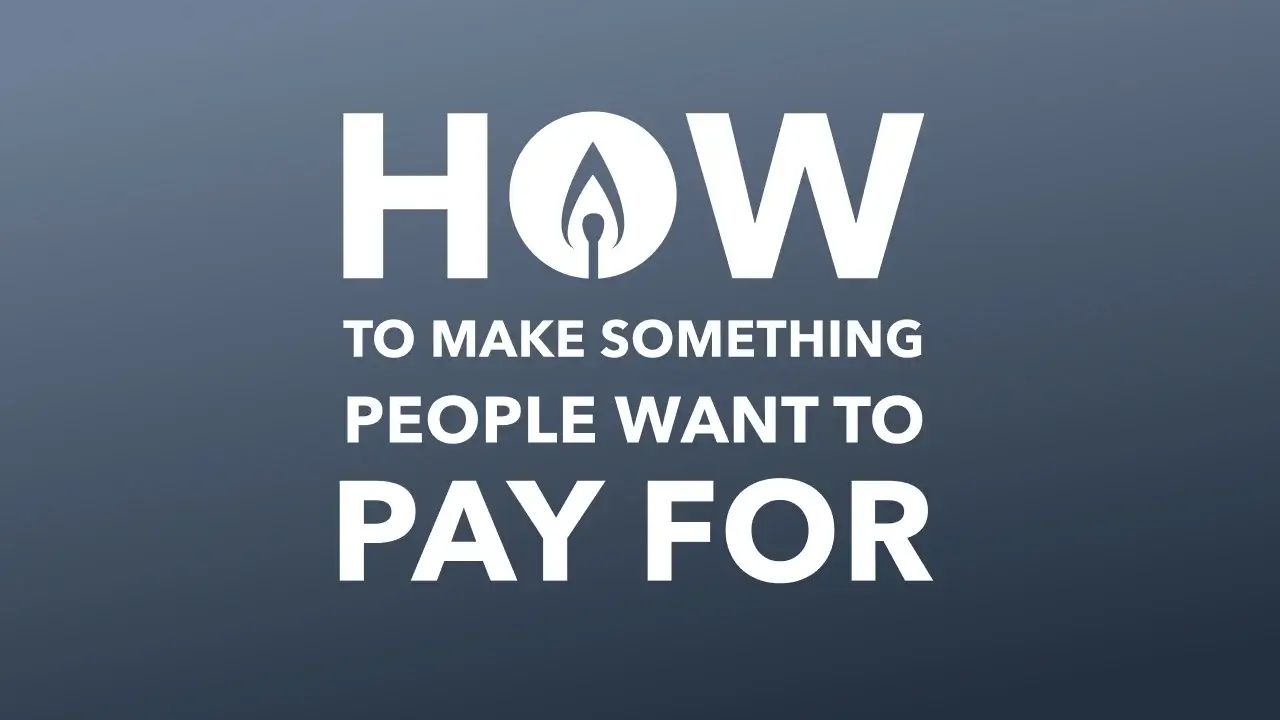How to Make Something People Want to Pay For
- Growth
- 18 mins
Introduction
As an entrepreneur, you get lots of generalized advice that’s easy to agree with but hard to follow, because it’s not clear how, exactly, to follow the advice.
Here’s one, popularized by YC but used by many people in many forms:
Make something people want.
Easy to agree with.
But how, exactly, do you do make something people want?
To get started, if your goal is to build a business instead of just a product, (that is to say, if your goal is to avoid building a product that fails, but rather to build a product that supports a healthy, high-margin business), I’d suggest rephrasing it:
Make something people want to pay for.
Below, I’ll lay out one way you can make something people want to pay for.
Zach Fragapane and I developed this process through a series of pivots, some caused by not using such a process in the first place, and others caused by a lack of planning for the risk of unforeseen market changes like the Covid pandemic.
Overall, though, I think all (I do mean actually 100%) of the challenges we’ve faced stem from the root cause of not adequately understanding our customer.
And I now believe that nearly all of the challenges faced by pretty much all founders stem from that same place.
This isn’t the only way to make something people want to pay for, I’m certain. This is just one way. It’s worked for us and there’s no reason why it shouldn’t also work for lots of other entrepreneurs.
So, let’s get into it.
Why do people want to pay for things?
People want to pay for solutions to their problems.
People want to pay for solutions to their problems because they desire some outcome they can only achieve if the problem is solved.
So, here we define a problem to be a thing that prevents the person from achieving some desired outcome.
Not all problems are created equal.
Some problems are mild annoyances, while others cause major burning pain. The latter we call Big Painful Problems.
The severity of pain caused by a problem is a function of two things: 1) how strongly the person desires the outcome, and 2) how in/adequate the existing solutions are at solving the problem. (Note: in/adequacy is a function of both effectiveness and cost).
Your first job as a founder is to identify a big painful problem that a well-defined customer is willing to pay to solve, for which the existing solutions are ineffective and/or expensive.
Once you’ve done that, and ONLY once you’ve done that (i.e. do not proceed until you’ve done that), then your second job is to identify what solution the customer most desires to solve that problem and ensure their willingness to pay for that solution will support whatever growth engine is required to get the product to market.
You can do all of this yourself, without hiring anyone or raising any money from investors.
Here’s how.
The Two Discovery Stages You Must Go Through, In Order
As described above, there are two stages you must go through, and you must go through them in order:
- Validate the customer problem
- Validate the solution and pricing
In each stage you will be using the same cyclical process:
- Create an asset
- Get feedback from customers on the asset
- Use the feedback to improve the asset, and repeat
However, in each stage, the actual asset you will use differs, and the data you must collect to achieve validation differs.
Stage 1: Validate the Customer Problem
To validate the customer problem, the asset you’ll use is called a Need Narrative.
It’s a written statement of who the customer is, their problems, desired outcomes, existing solutions, adequacy of those solutions, etc.
Once you create it, gather feedback by conducting cycles of 3-5 “semi-structured problem interviews” during which, among other things, you’ll read the Need Narrative to the interviewee and getting their feedback on it.
· · · ·
PAUSE! This is a very important note about customer qualification:
It’s important to note that you must ensure the people you interview are qualified as matching your customer definition, otherwise you won’t know whether you can trust their feedback.
While it’s tempting to use loose, generic criteria for defining (and thus dis/qualifying someone as) your customer, you should resist this temptation.
Instead, I suggest being extremely specific, using what Zach Fragapane calls “Externally Identifiable Information.” This means any information you can find publicly or using data sources; for example, anything that’s a search filter in LinkedIn Sales Navigator would be considered externally identifiable information.
At this stage, you want to say, “If someone has these ten (or 5, or 20) characteristics, all of which are externally identifiable, I hypothesize they will tell me my Need Narrative is a perfect reflection of their reality.
As you move through interview cycles, you want to reach the point where you can say, “If someone has these ten (or 5, or 20) characteristics, all of which are externally identifiable, I am 90% confident they will confirm my Need Narrative is perfect and they will ask for more info about what sort of solution I’m building.”
To learn how you can reach that point, keep reading.
Oh, and as you can probably see, you’re now beginning to exercise the muscles that will ultimately become your go-to-market: the ability to create target customer lists for sales, audiences for marketing/ads, etc.
· · · · · · · · · · · · · · · · · · · · · · · · · · · · · · · ·
Now then. After you complete a cycle of 3-5 interviews, use the feedback to iterate on the Need Narrative and make it more reflective of the reality your hearing from your interviewees.
The first key data point to collect in early interviews is qualitative: we call it the Nod Rate. When you read the Need Narrative during the interview, is the interviewee nodding affirmatively? For approximately what percentage of the Need Narrative were they nodding? Are they kind of “bobbing” or are they really nodding affirmatively, enthusiastically?
The second key data point to collect in all of the interviews is quantitative: what percentage of interviewees confirmed that 100% of the need narrative is correct, i.e. it accurately reflects their reality; you should be hearing things like, “Wow, you really get this” or “Wow, feels like you know me better than I know myself.”
The third key data point to collect is also quantitative: what percentage of interviewees exhibit early buying behavior at the end of the interview? At this stage, “buying behavior” means they are saying things like, “I’m interested in what you’re making to solve these problems, can you share with me?”
When all of those things are happening, you can be confident that your Need Narrative is validated, meaning that it’s an accurate reflection of reality.
A validated Need Narrative is a factual description of a well-defined customer and their main problems, the outcomes they hope to achieve by solving those problems, and the existing solutions they use to try to solve the problems.
But wait.
There’s one more thing to ensure at this point, and it’s important: how likely is it that the customer will pay for a solution to this problem? If the likelihood is low, be super careful, because it means you might end up building a solution that you can’t effectively sell, i.e. that customers won’t want to pay for.
Confidence that a customer will pay for a solution to the problem doesn’t come from asking whether they’d pay.
Confidence that a customer will pay for a solution comes from factual evidence that they are currently paying to try to solve it (or recently paid to try to solve it).
In addition to demonstrable evidence they are paying or recently paid to try to solve it, it’s especially good if they’re dissatisfied with the effectiveness of the solution(s) they’re paying for.
To put it simply, a good business opportunity looks like this: a well-defined customer with a big painful problem (blocking them from a strongly desired outcome) with existing solutions (that they’re currently paying for) that are both expensive and inadequate at solving the problem.
If you have not found one of these, it is well worth your time as an entrepreneur to focus (pretty much exclusively, I would argue) on finding one.
On the other hand, once you have proven that you found one of these, it is well worth your time as an entrepreneur to proceed to validating the solution.
Note that you should not proceed directly to building product. You need to validate the solution before you know what product to build.
Stage 2: Solution Validation
To validate your solution, the asset you’ll use is called a Solution Statement. It’s a description of a solution that a specific customer might use to solve a problem, the “hook feature” that they’d get started with, the “retention features” that provide additional ongoing value, the reasons why they love the solution, and the reasons why common concerns about the solution are unfounded.
To get feedback on the Solution Statement, you’ll conduct cycles of 3-5 semi-structured solution interviews, during which (among other things) you’ll read the solution statement to the customer and get feedback on it.
Use their feedback to iterate on the Solution Statement.
Similar to the data you captured during the first stage, you’ll know when your solution is validated when your interviewees are affirming that the solution described in the statement is 100% attractive and they are exhibiting buying behavior: “This sounds awesome, what’s the pricing?”, “Are there people already using this?”, “Is this easy to get started?”, “When will this be available?”.
There are two really important signals here:
- Will the interviewee take a conversion action?
- Will the interviewee refer someone else who may be interested?
Conversion actions can be a range of things: entering their email for a waitlist or scheduling a followup call to review the product in more detail, all the way down to pre-paying for access.
The higher the bar you set for the conversion action, the more confident you can be as you proceed. I suggest setting the bar really high, like asking for money, but it’s up to you.
Money, you say? But, how do I know how much money to ask for?
Ah, yes.
Figure out how much customers will pay for your solution
Once you’ve validated that the customer desires the solution, as described above, you can do some simple but effective pricing research. This approach is derived from the amazing book Monetizing Innovation, which I highly recommend.
Here’s how to do it:
- First, validate the pricing model.
- Then, validate the price itself.
At this point, you aren’t going for perfection.
You just need to find a price that customers want to pay for the solution you’ve validated; you can get more precise later.
The best two ways to validate the pricing model are:
- Find analogous products and see if they all use a similar pricing model, and
- Ask your interviewees what pricing model they would expect for your solution
Without too much hassle, this should help you land on a pricing model.
Once you’ve found the pricing model your customers prefer, you can ask them three questions:
- What is an acceptable price for this solution?
- What is an expensive price for this solution?
- What is a prohibitively expensive price for this solution, at which point you would not try it?
If your pricing model has multiple components (e.g. an upfront fee plus an ongoing monthly subscription), you will need to ask those three questions for each component.
I suggest selling your early customers at a price between acceptable and expensive, but a bit more toward the expensive price.
However, before you proceed, you need to build confidence that the price your customers are willing to pay will support a solid business. There are two pieces to this.
- You need to project your operating expenses required to deliver the solution, to mitigate the risk that you build a crappy low-margin business, aka increase the likelihood that you build a solid high-margin business
- You need to project your customer acquisition costs, to decrease the risk that you end up unable to afford the only channels that work to acquire your customers, aka increase the likelihood you can happily afford to acquire customers via whatever channel(s) end up working to acquire this particular customer
Both of these financial projections are easier to do than you might imagine.
Start by building a financial model. I won’t cover best practices for financial modeling here, but I will say that your early financial model can be much, much simpler than others might imply. It should take a couple of hours, maybe.
Be conservative (i.e. overestimate each key cost, underestimate sales growth).
You’re looking for ballpark confidence that your operating margin will be high.
When it comes to customer acquisition cost, it’s important to understand that the channels by which you can grow your business are determined by the price the customer is willing to pay for your solution.
All of these are ballparks, just for example: If they’re willing to pay no more than $100 per year, you’re looking at SEO, virality, maybe some incentivized WOM. If they’ll pay up to $500 per year, you might be able to make paid social or paid search work, but it will be close. If they’re willing to pay up to $5,000, paid advertising is possible. If they are willing to pay you more than $5,000 per year, then outbound sales could be a viable channel.
At this point, you just want to build some confidence that you don’t accidentally get into a situation where, for example, your product/customer combination requires outbound sales but the customer’s willingness to pay isn’t high enough to support sales as a growth engine.
Don’t worry about getting super granular here.
Just be intellectually honest with yourself: do you believe that the growth engines available to you (as determined by the customer’s willingness to pay) have a high likelihood of working for this particular customer, for this particular problem, for this particular solution?
Just to illustrate with a simple example, if your target customer is enterprise CEOs, but they are only willing to pay you $200 per year for your solution, you may have a hard time with go-to-market because it’s hard to get an enterprise CEOs attention without some sort of sales operation.
But, if you find yourself in this type of situation, all is not lost.
Because you already validated that this is a big painful problem, customers should be willing to pay more for a solution.
It’s possible that the way you’re describing the solution is causing the customer to anchor the price against something inexpensive. So, repositioning the solution could cause them to anchor the price against something more expensive.
If you can figure out how to get the customer to anchor the price against something more expensive, it’s likely their willingness to pay will go up, for the same solution.
I have personally faced this situation, and by repositioning the solution we increased the customer’s willingness to pay from ~$200/month to $2,000/month—a roughly 10x increase in willingness to pay without changing the actual solution at all.
In turn, this increase enabled us to gain confidence that our go-to-market would work (because we hypothesized outbound sales would be required) and that our operating margins would be high. So, we had the confidence to begin selling.
Generating Revenue from The Start
When you reach this point, you have:
A clearly defined customer with a big painful problem that they’re willing to pay money to solve, and an understanding of the outcomes they desire to achieve by solving the problem
A well-defined solution that the customer desires to pay for, and confidence they’ll pay enough to support a high margin business that grows with acceptable customer acquisition costs
In other words, you’ve proven to yourself that it’s likely you can build something people want to pay for.
Unlike most entrepreneurs, you can now begin generating revenue from the get-go.
You can do this by creating the simplest possible version of your solution and selling it to your customers.
Just for example, let’s say the solution you validated is a SaaS product. You can begin selling a SaaS product to your customers before the product is built by stitching together off-the-shelf apps and humans to deliver essentially the same output your SaaS product will deliver.
If you’re transparent with your customers about this, they will be fine with it, because your customers don’t really care about how your product works, they mostly just care about getting the problem solved so they can achieve their desired outcome.
If you can pull this off, which I believe is easily doable in far more cases than many people believe, you have two massive advantages.
First, you now have optionality about when (and even whether) you raise money from investors. Now that you’re printing money, there’s no end to the runway. You make the calls.
Second, you have the best possible investor pitch: “Look at this money printing machine. When I put a little money into it, a lot more money comes out the other side. Want to invest?”
These two things help you get good terms from investors, so you retain more ownership of the business.
AND they reduce the likelihood of wasting time with investors who will never write you a check, because the vast majority of investors will not write you a check until you have a money printing machine. This isn’t a knock on investors, it’s just a fact that reflects the reality of their job.
Actually, there’s a third massive advantage: you will be having way more fun. There is absolutely no question that, as an entrepreneur, your work will be much more fun when you are making money than when you are not. Do yourself a favor.
Final Note part 1: You may not need to do anything I’ve described above
Some founders get there very quickly, without doing a single thing I’ve mentioned above.
I know some of them, and I respect them very much, but I’ll say this: there’s nothing particularly unique or unusual about them, except perhaps having good intuition about customers. Or, maybe they don’t have unusually good intuition; maybe the truth is the pieces just line up for some people faster than others. Heck if I know.
The people like this who I know simply saw or experienced a problem, had great intimacy with and empathy for the customer, intuitively understood the customer problem, and nailed the solution the first time around.
This is possible, but in my experience, it is quite rare.
I interact a lot with founders who’ve been accepted into a Techstars accelerator, and of these founders, I’d say about 75% of them still ought to do what I described above, and maybe 25% of them have already gotten it right intuitively.
When I interact with founders not associated with an accelerator, the ratio is more pronounced. Maybe 1 out of 100 got it right intuitively.
Overall, these people who get it right intuitively are, by far, the minority.
When these types of founders hear me talk about studying customers in this manner, they say things like, “Man, you need to stop experimenting so much and just get to selling” or “Look, you’re doing too much of this discovery thing. You gotta just hit the gas.”
To them, what I’ve described above sounds like a waste of time, because they haven’t been in a situation where it’s necessary.
There’s just no use in trying to explain it; they won’t understand, even if they say they do.
Final Note part 2: There are probably better ways to do this
There are probably better ways of doing what I’ve described here.
I have no illusions that there is just one way to make something people want to buy.
If you know of a better way, please let me know.
This is simply “a” way that my co-founder and I developed because, well, we kept creating things that people didn’t want to buy, and we got really tired of that.
We weren’t able to find a clear, step-by-step process for doing this, so we made one for ourselves.
I hope it works for you, or maybe one little piece of this will help you in some way.
I believe there is still a lot to be done to help entrepreneurs. Just look at the failure rate of startups.
All of us know the reverberating positive impact that one single successful entrepreneur can have on the world.
Figuring out ways to help entrepreneurs avoid failure and achieve success faster sees like a good way to spread love in the world.
· · · · · · · · · · · · · · · · · · · · · · · · · · ·
Why did I write this?
Having now helped a bunch of other founders use this process, or parts of it, to fill the gaps in their businesses, I decided to write this article so I wouldn’t have to explain this one-by-one to other founders.
If you found this helpful, please let me know.
Perhaps it will inspire me to write down some of the other stuff that’s been bouncing around on the back-burner.
— Shelby



